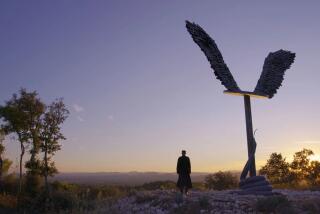Restoring the tragicomic tone to Bas Jan Ader
Bas Jan Ader (1942-1975), the Dutch-born Conceptual artist who lived in Los Angeles, produced a modest body of work that has been largely overtaken by the mythic aura surrounding his death. A small show at Meliksetian Briggs does a very good job of sweeping aside the story-book cobwebs, refocusing the view.
Forty years ago, Ader climbed into a small sailboat and set off for England from the Massachusetts coast, generally reversing the path of Pilgrim colonization of the New World. He was lost at sea — “In Search of the Miraculous,” as the title of the ill-fated performance had it — and his body was never found.
Organized for the gallery by Pedro de Llano, curator of a 2010 Ader retrospective in Spain, the show is smartly titled “Drifting Home.” The cheeky title, coupled with the wretched circumstances of the artist’s death, brings wit to the tragedy. The tragicomic tone of Ader’s Conceptualism is restored.
The show consists of six photographs, an artist’s book and a lithograph, plus one short film and a video performance, both on DVD. The film shows Ader crawling through rural underbrush and coming upon an animal trap. Inside, elegant afternoon tea has been set out. He indulges and, slam!, the trap is sprung.
So much for culture as a refuge from nature, or domesticity as liberation. Beware the conventions of gentility.
Performing “The boy who fell over Niagara Falls” (1972), Ader sits in a comfy chair by a table lamp reading aloud a short story about a man and boy in a boat, caught by the current. Over the falls they go. The man dies, the boy survives — a conventional metaphor for an artist’s supposed need to maintain childlike innocence.
Ader repeatedly reaches over to take a sip from a glass of water, which he absentmindedly keeps returning to a spot precariously close to the table’s edge. This goes on for more than 15 minutes, the story and the water finally finishing simultaneously. Boredom alternates with anxiety over the possibility of shattered glass.
It doesn’t happen. This artist doesn’t go over the watery edge, except imaginatively.
The duration of the performance is perfect — just long enough to be effective, not too long to upset the compositional balance. The Niagara story came from Reader’s Digest, which explains the bite-size scale.
The popular magazine is also the subject of “473 Reader’s Digests digested,” documented in a queasy yellow photograph. Ader mulched copies of the middlebrow magazine in a backyard compost heap, later moving the pile into his studio and adding grow lights to accelerate the decay.
Entropy was very much on artists’ radar screens in 1970, thanks to the writing of Land artist Robert Smithson. In Ader’s dumpy little suburban Earthwork, nature gets a helping hand — sped along by the zooming pace of cultural modernity.
Meliksetian Briggs, 313 N. Fairfax Ave., (323) 828-4731, through March 14. Closed Sunday and Monday. www.meliksetianbriggs.com
More to Read
The biggest entertainment stories
Get our big stories about Hollywood, film, television, music, arts, culture and more right in your inbox as soon as they publish.
You may occasionally receive promotional content from the Los Angeles Times.







